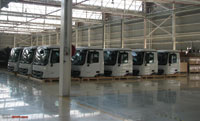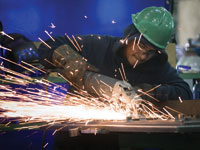A widespread misperception exists in our country that we have lost our manufacturing base – that manufacturing has migrated to other countries while we have evolved into something called a “service economy.” In reality, the United States was and remains the world’s largest manufacturer in terms of the dollar value of manufactured products. Manufacturing remains the core driver of innovation and economic growth.
 Without question, a substantial portion of our low-tech manufacturing has shifted overseas. China in particular has aggressively expanded into the manufacture of consumer products that today flood discount stores from coast to coast.
Without question, a substantial portion of our low-tech manufacturing has shifted overseas. China in particular has aggressively expanded into the manufacture of consumer products that today flood discount stores from coast to coast.
But the United States still dominates the more advanced industries – capital equipment, aerospace, machine tools, computer technology, robots, pharmaceuticals, chemicals, missiles, heavy earthmoving equipment, etc. You see the “Made in China” label on your child’s stuffed toy; you don’t see the “Made in USA” label on the satellite spinning overhead.
It is true that manufacturing is no longer the job creator it was a generation ago. This is largely because of quantum leaps in manufacturing productivity that always translate into fewer jobs. But by and large, they are more advanced jobs that offer excellent pay and benefits. In fact, one of the biggest problems facing our manufacturers today is the scarcity of qualified manufacturing workers.
“Dream It, Do It”
The National Association of Manufacturers (NAM), which I am privileged to lead, is doing something about this problem. Through our “Dream It, Do It,” program, we are active in many communities around the nation working with local schools, businesses and community colleges to attract a new generation of bright, young manufacturing workers.
Our young people have a dated notion of what modern manufacturing is about. It’s not your father’s factory floor today; the modern manufacturing facility is “Star Trek” – clean, busy and highly computerized (but without the Klingons). Not everyone wants or needs a four-year liberal arts degree. I know many bright young people who have parlayed practical courses at community colleges, usually within two years, into excellent jobs in manufacturing earning much more than four-year liberal arts grads.
NAM’s Mission The story of the skills gap is only one of many on the NAM’s agenda. Representing about 11,000 manufacturers of every size, in every industrial category andin every state, the NAM is the nation’s largest industrial trade association. Our mission is to enhance the competitiveness of manufacturers by shaping a legislative and regulatory environment that encourages investment and economic growth.
The story of the skills gap is only one of many on the NAM’s agenda. Representing about 11,000 manufacturers of every size, in every industrial category andin every state, the NAM is the nation’s largest industrial trade association. Our mission is to enhance the competitiveness of manufacturers by shaping a legislative and regulatory environment that encourages investment and economic growth.
In the current economic environment, that is challenging. The global marketplace is more competitive than ever before. Our government does not truly grasp the need to strengthen manufacturing and enable us to become more competitive.
Grasping the Need of Competitiveness
We see spending proposals, like health care reform, that the Congressional Budget Office (CBO) estimates will cost $1.6 trillion and would not come close to providing everyone with health insurance. There are many things we can do to reduce the cost of health care and extend insurance to more people, but we must be careful to build upon our excellent health care system, not undermine it.
We see proposals like cap-and-trade to control emissions of carbon dioxide, a strategy that by definition must raise the costs of energy.
And the so-called Employee Free Choice Act (EFCA) would turn traditional labor relations upside down, allowing unions to impose themselves on workplaces and forcing those companies to accept contracts dictated by federal arbitrators. This can only foster animosity between management and labor, raise the cost of production and undermine productivity.
As the Administration and Congress review these many different plans and programs, one word is too often missing from their considerations: Competitiveness. Manufacturers in the United States operate in a global economy, and every new burden, cost or requirement directly affects our ability to compete.
The NAM is working energetically to make certain our government understands the importance of manufacturing to the U.S. economy and gives the challenge of competitiveness priority attention. For more information about these issues, and to learn how you can help, please go to www.nam.org.

